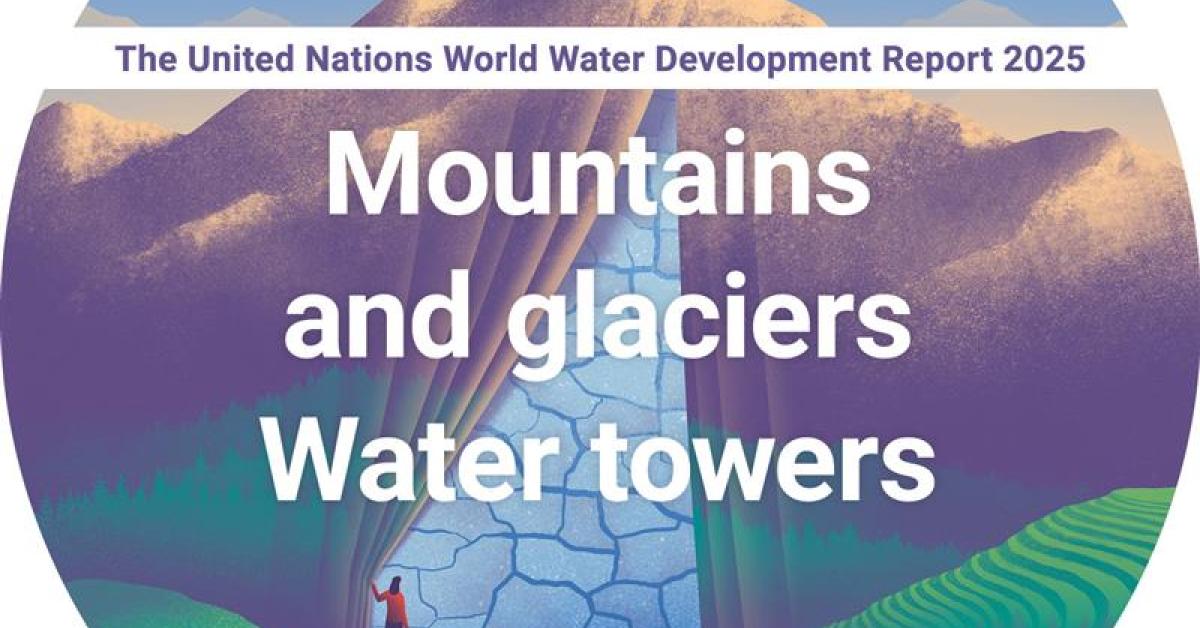- Courses
- GS Full Course 1 Year
- GS Full Course 2 Year
- GS Full Course 3 Year
- GS Full Course Till Selection
- Answer Alpha: Mains 2025 Mentorship
- MEP (Mains Enrichment Programme) Data, Facts
- Essay Target – 150+ Marks
- Online Program
- GS Recorded Course
- Polity
- Geography
- Economy
- Ancient, Medieval and Art & Culture AMAC
- Modern India, Post Independence & World History
- Environment
- Governance
- Science & Technology
- International Relations and Internal Security
- Disaster Management
- Ethics
- NCERT Current Affairs
- Indian Society and Social Issue
- NCERT- Science and Technology
- NCERT - Geography
- NCERT - Ancient History
- NCERT- World History
- NCERT Modern History
- CSAT
- 5 LAYERED ARJUNA Mentorship
- Public Administration Optional
- ABOUT US
- OUR TOPPERS
- TEST SERIES
- FREE STUDY MATERIAL
- VIDEOS
- CONTACT US
United Nations World Water Development Report
United Nations World Water Development Report

- On March 22, 2025—World Water Day—UNESCO released the United Nations World Water Development Report (WWDR) 2025 on behalf of UN-Water.
- This year’s theme, "Mountains and Glaciers: Water Towers," highlights the critical role of mountain systems and alpine glaciers in sustaining ecosystems, societies, and economies across the globe.
- Recognizing this urgency, the UN has also designated 2025 as the International Year of Glaciers’ Preservation, drawing attention to the increasing vulnerabilities of these essential freshwater sources amidst climate change.
Background: Global Water Trends and SDG Progress
- Freshwater is under immense stress globally. As of 2021, agriculture accounted for 72% of global water withdrawals, followed by industry (15%) and domestic use (13%).
- From 2000 to 2021, total freshwater withdrawals rose by 14%, driven mainly by rapid economic development rather than population growth.
- Alarmingly, 25 countries—home to a quarter of the global population—face extreme water stress, and 4 billion people experience severe water scarcity during some part of the year.
- Despite the vision of Sustainable Development Goal (SDG) 6—ensuring availability and sustainable management of water and sanitation for all—progress is critically off track.
- In 2022, 2.2 billion people lacked access to safely managed drinking water, and 3.5 billion lacked basic sanitation services. Rural areas suffer the greatest disparities, especially in Sub-Saharan Africa, Central and Southern Asia, and Latin America.
Mountains and Glaciers: The World’s Natural Reservoirs
The report identifies mountains as Earth's natural freshwater towers, noting:
- Mountains cover 24% of global land and house 1.1 billion people.
- They contribute 55–60% of the world’s annual freshwater flow.
- Major rivers—including the Indus, Nile, Colorado, and Amu Darya—derive up to 90% of their flow from mountain sources.
Mountains also support biodiversity, with 25 of the 34 global biodiversity hotspots located in mountain regions. Forests cover 40% of mountain areas, providing key ecosystem services like water regulation, slope stabilization, and carbon storage.
Glacier Loss and Cryospheric Changes
The mountain cryosphere—including glaciers, snowfields, and permafrost—is one of the most climate-sensitive components of the planet. Key threats noted in the report include:
- Accelerating glacier melt and snow cover loss due to global warming.
- Rising GLOF (Glacial Lake Outburst Flood) risks, with 3,151 events recorded and $56 billion in damages from 1985 to 2014.
- Projected glacier mass loss of 26–41% by 2100.
Factors such as dust, black carbon, and red algae blooms (watermelon snow) reduce surface albedo, further accelerating melt. These changes affect streamflow, sediment loads, and disaster risks in downstream regions.
UN's Observations on Food Security in Mountain Areas
The report reveals that:
- 648 million rural mountain residents depend on agriculture and pastoralism.
- 35–40% of mountain dwellers face food insecurity.
- 80% of crop and livestock losses in mountain areas are caused by climate hazards.
The report highlights Indigenous farming techniques such as terrace farming and traditional irrigation as vital adaptation strategies. It recommends ecosystem-based adaptation (EbA) to build climate resilience.
Human Settlements and Water Infrastructure Risks
UNESCO notes that about two-thirds of mountain inhabitants now live in urban or peri-urban areas. These settlements are exposed to:
- Landslides, floods, earthquakes, and GLOFs.
- Infrastructure challenges due to rugged terrain and high elevation.
- Strain on water and sanitation systems due to unplanned urbanization.
The report suggests decentralized systems, early warning mechanisms, and feasibility studies for infrastructure to reduce disaster vulnerability.
Industrial and Energy Uses
- Mountains support water-intensive industries including lithium mining and cryptomining, both of which increase water demand.
- Hydropower dominates the energy sector, with 95% of global pumped storage hydropower (PSH) located in mountain areas.
- In Latin America, 85% of hydroelectric power comes from mountain rivers.
- However, development is constrained by elevation-related costs. Poor regulation in remote areas also leads to uncontrolled water withdrawals and pollution.
- Sustainable approaches like circular economies, green infrastructure, and cleaner technologies are being promoted to reduce ecological harm.
Ecosystem Services and Environmental Significance
- Mountain ecosystems provide crucial services such as water regulation, carbon sequestration, flood control, and biodiversity conservation.
- High-altitude soils, particularly those with permafrost, store an estimated 66 petagrams of organic carbon—around 4.5% of the global total.
- These ecosystems are vulnerable to degradation. Currently, 57% of global mountain areas face intense human pressure.
- Nature-based solutions (NbS) and ecosystem-based adaptation are now recognized as key strategies to maintain these services and mitigate climate impacts.
UN Regional Findings on Mountain Water Challenges
- Sub-Saharan Africa
- 252 million people live in mountain regions.
- Glaciers in Mount Kenya, Kilimanjaro, and Rwenzori may vanish by 2040.
- High population density, deforestation, and poverty threaten water security.
- Europe and Central Asia
- Alpine glaciers are shrinking rapidly, threatening water supply.
- River discharge from the Alps could decline by 45% by 2100.
- Water-energy conflicts exist between upstream and downstream countries in Central Asia.
- Latin America and Caribbean
- One-third of the region is mountainous.
- The Andes have lost 30–50% of glacier volume since the 1980s.
- 85% of Latin America’s hydropower depends on mountain rivers.
- Asia and the Pacific
- The Hindu Kush Himalayas (HKH)—known as the Third Pole—cover 5 million km² and supply 10+ major rivers.
- HKH glaciers are melting 65% faster than before.
- Black carbon, heavy metals, and industrial pollution threaten the cryosphere.
- Arab Region
- Mountains like the Atlas and Mount Lebanon supply up to 60% of freshwater.
- Reduced snowfall is impacting agriculture and sanitation.
- Aquifer recharge and water harvesting are recommended adaptation strategies.
Recommendations on Governance and Capacity
The report stresses that governance and finance mechanisms in mountain water management need urgent attention:
- Only 43 of 153 countries have operational transboundary water-sharing frameworks.
- National policies often favor lowland users, neglecting mountain-specific needs.
- Citizen science, community engagement, and Indigenous participation are critical.
A significant adaptation finance gap remains: although $187 billion/year is needed, only $13.8 billion was mobilized in 2022. The report calls for innovative, inclusive financing models and mountain-specific programs in national development plans.
The UN World Water Development Report 2025 issues a clear warning: mountains are not just remote landscapes—they are vital, life-sustaining ecosystems whose decline will have global consequences. Their protection is crucial for ensuring water, food, energy, and ecological security worldwide.
The report concludes with a reminder that must guide global water policy:
"Nothing that happens in mountains stays in mountains. In one way or another, we all live downstream."
|
Also Read |
|
UPSC Foundation Course |
|
| UPSC Monthly Magazine | CSAT Foundation Course |




